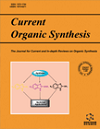- Home
- A-Z Publications
- Current Organic Synthesis
- Previous Issues
- Volume 8, Issue 5, 2011
Current Organic Synthesis - Volume 8, Issue 5, 2011
Volume 8, Issue 5, 2011
-
-
Editorial [Hot Topic: 2-Isoxazolines in Synthesis (Guest Editor: Cindy C. Browder)]
More LessOver the past decade, 2-isoxazolines (Δ2-isoxazolines, 4,5-dihydroisoxazoles) have seen a vast increase in their use, both as intermediates in the synthesis of natural and unnatural products, and as bioisosteric functionalities in medicinal compounds. As a result, a number of new methods and expansions in traditional techniques have emerged for the preparation and derivatization of 2-isoxazolines. Considering the burgeoning Read More
-
-
-
Recent Advances in Nitrile Oxide Cycloadditions. Synthesis of Isoxazolines
More LessAuthors: Digamber Rane and Mukund SibiSynthesis of novel heterocyclic compounds continues to be an important and challenging task. Isoxazolines are one such class of heterocyclic molecules of significance, since they are frequently found in many compounds that show significant biological activity. They are also of importance since they can be easily transformed into important functional groups. Nitrile oxide cycloaddition with carbon dipolarophiles represents Read More
-
-
-
Recent Advances in Intramolecular Nitrile Oxide Cycloadditions in the Synthesis of 2-Isoxazolines
More LessThe utility of 2-isoxazolines (Δ2-isoxazolines, 4,5-dihydroisoxazoles) in the preparation of natural products and other compounds of medicinal and materials interest is growing because the 2-isoxazoline serves both as a desirable functional group and a versatile synthetic intermediate. Nitrile oxide cycloaddition (NOC) to alkenes is the most common method for the preparation of 2- isoxazolines, and the intramolecular version Read More
-
-
-
Non-dipolar Cyclization Methods for the Preparation of 2-isoxazolines and 2-isoxazoline N-oxides
More LessMethods for the synthesis of 2-isoxazolines and 2-isoxazoline N-oxides that do not involve the [3+2] cycloaddition of a nitrile oxide are reviewed.
-
-
-
Methods of Cleavage of 2-Isoxazolines
More LessAuthors: Jaipal R. Nagireddy, Mohammed-Abdul Raheem, Jamie Haner and William TamThis review details the numerous methods of cleavage of 2-isoxazolines and the application of these methods in the synthesis of natural products. 2-Isoxazolines can be cleaved to provide a vast array of functionalities depending on the cleavage conditions used and nature of the substrate. Several cleavage reactions of 2-isoxazolines are covered, including, reductive cleavage by hydrogenolysis using various metal catalysts Read More
-
-
-
Synthesis and Applications of Group 14-metalated Arylboranes
More LessAuthors: Pawel Kurach and Sergiusz LulinskiThe review deals with the chemistry of bimetallic systems containing boron and one of group 14 metalloids or metals attached to the aromatic nucleus. Synthetic approaches to these compounds are described. This is followed by an overview on various applications of these compounds in organic synthesis, supramolecular and material chemistry.
-
-
-
Recent Progress in the Green and Efficient Synthesis of Biologically Privileged Scaffolds in Ionic Liquids
More LessAuthors: Xuesen Fan, Xinying Zhang and Jianji WangIn this review, the recent progress in the use of room temperature ionic liquids (RTILs) as reaction media and/or catalysts for the synthesis of various biologically privileged compounds, mainly heterocycles and nucleoside derivatives, is described.
-
-
-
Efficient Synthesis of Fused Pyrimidine Derivatives with Biological Activity via Aza-Wittig Reaction
More LessAuthors: Ren Qingyun, Tan Xiaosong and He HongwuPyrimidine derivatives have played an important role in the chemistry of biological systems. This review focuses on recent work of our studies on the synthesis and biological activity of fused pyrimidine derivatives including pyrido[4,3-d]pyrimidine-4(3H)- ones; 3,4-dihydro-pyrido[4,3-d]pyrimidine-8-carbonitriles; pyrazolo[3,4-b]pyrido[4,3-d]-pyrimidine-4-ones; thieno[3',2'-5,6]pyrido [4,3- d]pyrimidin-4(3H)-ones; 1,2,3-tr Read More
-
-
-
Rhodium(I) N-Heterocyclic Carbene Complexes as Catalysts for Hydroformylation of Olefins: An Overview
More LessThe present state of art on the application of carbene-rhodium complexes as stable catalysts for hydroformylation reaction is described. A critical analysis of the influence of pressure and temperature on the hydroformylation of non-modified rhodium complexes and those ones described in the presence of carbenes is also done. Finally, a set of experiments using NHCs prepared by us at different reactions conditions is prese Read More
-
Volumes & issues
-
Volume 22 (2025)
-
Volume 21 (2024)
-
Volume 20 (2023)
-
Volume 19 (2022)
-
Volume 18 (2021)
-
Volume 17 (2020)
-
Volume 16 (2019)
-
Volume 15 (2018)
-
Volume 14 (2017)
-
Volume 13 (2016)
-
Volume 12 (2015)
-
Volume 11 (2014)
-
Volume 10 (2013)
-
Volume 9 (2012)
-
Volume 8 (2011)
-
Volume 7 (2010)
-
Volume 6 (2009)
-
Volume 5 (2008)
-
Volume 4 (2007)
-
Volume 3 (2006)
-
Volume 2 (2005)
-
Volume 1 (2004)
Most Read This Month
Article
content/journals/cos
Journal
10
5
false
en


